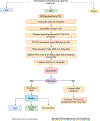Management Aspects of Medical Therapy in Graves Disease
- PMID: 39701285
- PMCID: PMC12005956
- DOI: 10.1016/j.eprac.2024.12.012
Management Aspects of Medical Therapy in Graves Disease
Abstract
Objective: Graves disease (GD) is the most common cause of hyperthyroidism. Treatment options include antithyroid drugs (ATDs), radioactive iodine, and surgery. In this review, we focus on the medical aspects of managing GD.
Methods: The authors conducted a literature review of PubMed to include studies and review articles on GD management, ATDs, long-term safety of antithyroid drugs, hyperthyroidism in pregnancy, Graves ophthalmopathy, and special circumstances related to hyperthyroidism.
Results: In adjunction to ATDs, medical management for GD also includes beta-blockers, glucocorticoids, and iodine containing agents. ATDs are currently the preferred option for initial management of GD, reflecting a shift in practice observed in the United States over the past 2 decades. ATDs in appropriate doses are well-tolerated and safe when used for longer duration, during pregnancy, and other circumstances discussed in this article. Routine thyroid function tests are important for monitoring. Thyrotropin receptor antibody plays an essential role in determining duration of treatment and assessing the likelihood of recurrence.
Conclusion: Medical management of GD with antithyroid drug is safe and effective. Long-term use beyond 24 months in patients with elevated thyrotropin receptor antibody is a reasonable alternative option to surgery and radioactive iodine due to higher rates of remission.
Keywords: Graves disease; antithyroid drugs; hyperthyroidism; thyroid function tests.
Copyright © 2024 AACE. Published by Elsevier Inc. All rights reserved.
Conflict of interest statement
Disclosure The authors report no conflict of interest.
Figures


Similar articles
-
A 2023 International Survey of Clinical Practice Patterns in the Management of Graves Disease: A Decade of Change.J Clin Endocrinol Metab. 2024 Oct 15;109(11):2956-2966. doi: 10.1210/clinem/dgae222. J Clin Endocrinol Metab. 2024. PMID: 38577717 Free PMC article.
-
Diagnosis and treatment of Graves disease.Ann Pharmacother. 2003 Jul-Aug;37(7-8):1100-9. doi: 10.1345/aph.1C299. Ann Pharmacother. 2003. PMID: 12841824 Review.
-
Management of Graves Thyroidal and Extrathyroidal Disease: An Update.J Clin Endocrinol Metab. 2020 Dec 1;105(12):3704-20. doi: 10.1210/clinem/dgaa646. J Clin Endocrinol Metab. 2020. PMID: 32929476 Free PMC article. Review.
-
Definitive treatment of Graves' disease in children and adolescents.Endokrynol Pol. 2021;72(6):661-665. doi: 10.5603/EP.a2021.0092. Epub 2021 Dec 2. Endokrynol Pol. 2021. PMID: 34855196
-
Management of Graves' hyperthyroidism: present and future.Expert Rev Endocrinol Metab. 2022 Mar;17(2):153-166. doi: 10.1080/17446651.2022.2052044. Epub 2022 Mar 14. Expert Rev Endocrinol Metab. 2022. PMID: 35287535
References
-
- Pokhrel B, Bhusal K. Graves disease. In: StatPearls. StatPearls Publishing; 2024.. Accessed October 13, 2024. http://www.ncbi.nlm.nih.gov/books/NBK448195/ - PubMed
Publication types
MeSH terms
Substances
Grants and funding
LinkOut - more resources
Full Text Sources
Miscellaneous

